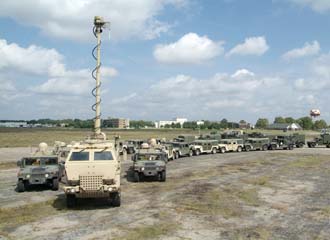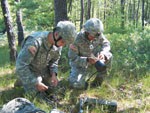Army Examines Network Parts Before They Become the Whole
 |
Command, Control, Communications, Computers, Intelligence, Surveillance and Reconnaissance On-The-Move (C4ISR OTM) vehicles and Program Manager Warfighter Information Network-Tactical (WIN-T) configuration items prepare to roll out for a mobile assessment of the 2013 Mobile Brigade Combat Team architecture. |
Developers are testing the many pieces that plug into the U.S. Army’s communications networks during the military branch’s annual system-of-systems event. The four-month exercise gives leaders a look at the network of the future. It also offers developers the opportunity to study many of soldiers’ critical assets in an operational venue, enabling experimentation outside of a laboratory. Understanding the real-world interoperability capabilities through these evaluations will help the Army ensure that predictions on paper become reality in the field.
The Army’s transition into a network-centric system-of-systems environment requires collaboration with the different organizations developing the various components that feed into the larger system. The Command, Control, Communications, Computers, Intelligence, Surveillance and Reconnaissance On-the-Move (C4ISR OTM) exercise offers a venue to test those capabilities in realistic environmental conditions, helping personnel explore what effect various field factors, including sun, wind and even wildlife, might have on functionality.
C4ISR OTM, an office under the Army’s Communications-Electronics Research, Development and Engineering Center (CERDEC), located at
This integrated capabilities event builds its tests around a series of critical activities focused on mitigating C4ISR risks at the system-of-systems level. High-level guidance shaping the design of this year’s (E10’s) work includes the Army’s strategy for Brigade Combat Team (BCT) modernization, a strategy to create a variety of mobile and networked BCTs. Planners designed E10 to focus on the technical performance of the transport layer at the network-of-networks level and to provide insight on the solutions sets for Unified Battle Command. Exercise designers review activities to ensure they tie back to the Army’s goals and objectives. In 2010, part of that work includes tying in more strongly than in years past with ongoing study efforts of the Assistant Secretary of the Army for Acquisition, Logistics and Technology. The studies determine what the Army network will look like in specific time frames and what capabilities will enable it. The C4ISR OTM E10 is examining the capability set for the Army network in 2013-2014.
In addition to the baselines CERDEC builds on, diversions are created to see how emerging technologies fit in with where the Army is moving on the big network. “It’s not just about communications, but it’s about how applications work,” Blohm says.
Some of the better-known Army activities that will participate this year include Warfighter Information Network-Tactical (WIN-T) Increment 2 with Highband Network Waveform and Network Centric Waveform; the Joint Tactical Radio System Wideband Networking and Soldier Radio waveforms; Command Post of the Future; Land Warrior; and Force XXI Battle Command Brigade and Below.
Other technologies include the Wireless Network After Next, a Defense Advanced Research Projects Agency program transitioning to the Program Executive Office for Command, Control and Communications-Tactical. It focuses on low-cost wireless solutions for scalable, adaptable and ad hoc networking. Another is the Maneuver Control System with Battle Command Server, an Army Battle Command System suite of systems that provides executive decision making capabilities, maneuver functional and battle staff tools and enterprise services.
The Communications Airborne Layer Expansion Joint Capability Technology Demonstration also will be assessed. This effort focuses on demonstrating interoperable, aerial layer network access and range extension for warfighters using an airborne layer architecture. Additionally, the Vehicular Integration for C4 and Electronic Warfare Interoperability, or VICTORY, an integration architecture designed for interoperability between electronic systems in Army vehicles, will be involved.
The live execution of the exercise is performed at
Participants come from around the military, including multiple program executive offices and acquisitions as well as academia and industry. Blohm says having everyone together makes a big difference to systems’ development. “It’s amazing what happens ... even in just a few days time,” he explains. The event is held in the summer in part because more soldiers are able to participate during that season. This year, troops from
 |
Soldiers performed missions during last year’s C4ISR OTM exercise and provided feedback on equipment. An event such as this, which places emerging technologies into the soldiers’ hands early in the process, allows warfighters to help industry shape and mature capabilities to better meet troops’ needs. |
By placing technologies together in a semi-field environment, developers can understand how pieces interoperate. In the testbed, personnel can stress systems, push scalability and connect capabilities in a contested fashion or spread them out over distances. By running systems to their breaking points, developers have a better understanding of what their products can accomplish. Blohm says that finding challenges means success, because by exposing what fails to work correctly, participants can go back and make fixes, often in real time with partners from other organizations. “They all come together, and this quiet little hamlet of
Wherever a program of record exists, CERDEC personnel want to bring that into their event. Blohm says his people look across the whole BCT modernization effort at where capabilities are today and where the Army needs to evolve them. The event helps drive science and technology investments to ensure new technologies provide real assistance to soldiers. The testbed, he explains, enables the Army and its partners to tie modeling and simulation back to real hardware and software. The event also allows the Army to perform risk reduction and mitigation on technologies in the research and development stage. The exercise accommodates nearly finished technologies as well as those that may require several years to mature.
Blohm believes the most important aspect of C4ISR OTM is bringing the entire network together in one environment so participants understand what works. “That’s probably the biggest impact we have,” he states. One example of success is the event’s work with WIN-T Increment 2. Developers of that system have used the event venue to prove technologies in the testbed.
In addition to the technology aspect, Blohm explains that the human aspect of the event also plays an important role in preparing systems. Participants can experience how humans interact cognitively with different technologies. This understanding helps elucidate the difference between digital natives and digital immigrants. Blohm says the experiments tend to reveal that natives trust what they receive from the network while immigrants can become paralyzed when they receive too much information. “Suffice it to say everyone adapts to this a little differently, and we’re trying to come up with systems that allow the users and user interfaces to be adaptive to their preferences,” he says.
Some participants return to the exercise year after year to reassess their technology. Jason Sypniewski, chief of C4ISR OTM’s Integrated Event Design and Analysis Branch, says that, “Our goal is always to mature and build on our best efforts.” He adds that, “Year after year the effort is always focused on continuing to build on previous efforts and mature our capabilities.” Planners try to increase complexity because that always becomes prevalent at the system-of-systems level. Users start to see behaviors that normally do not occur when technologies operate in a stand-alone fashion or in a laboratory.
Not only military-centric activities take part in the exercise. Sypniewski highlights a different type of technology at this year’s exercise—one that involves commercial cellular capabilities. The event is bringing in various providers to showcase 3G capabilities in the exercise venue to determine how they perform when integrated with the larger network. Sypniewski is interested in the results of the experiment because it will show how to integrate this technology in the tactical environment. It especially is relevant because most 19- to 20-year-old soldiers performing operations are accustomed to using cell phones.
The system-of-systems perspective of the C4ISR OTM exercise makes it unique, Sypniewski explains. “There are a lot of milestones they need to meet, but at the same time the Army network of the future isn’t made up of one specific capability or component,” he says. “It’s going to be a mix of an entire system of systems. They need to be assessed in a relevant environment.” That type of integration and assessment is possible only in a venue such as this exercise, not in a laboratory or on a PowerPoint slide, he adds.
All the assessments are done in a collaborative environment between the C4ISR OTM and its partners. Sypniewski says he prefers the term assess to evaluate because evaluate is too formal. The work done during the exercise is not based on specific metrics, but rather focuses on particular performance characteristics on the component and system-of-systems levels.
The assessments have a phased approach, where the executors start by looking at the components then integrate and test them together in a relevant environment. Sypniewski explains that the capstone of the exercise comes in August, when the integration aspects are tested.
The program does not label a capability a success based on whether or not it works. The event is not set up to prove anything, but rather to test, assess, analyze, fix and repeat as necessary. Sypniewski explains that reaching the breaking point of technologies is critical so developers can figure out what went wrong and make adjustments. The exercise brings developers, engineers and subject matter experts together on the ground so they can determine what needs to be done in a larger effort.
To put on such an involved exercise, the C4ISR OTM began its planning cycle in the fall, starting with a series of architecture working groups to put feelers out to the involved community. These groups tell others what the program is interested in and gather the feedback about what developers want. Then, more formal planning conferences with key stakeholders occur to refine the pieces. Though the work begins at the C4ISR OTM level and that staff is involved during the entire process, the efforts extend all the way to the top of CERDEC and its parent command, the Army Research, Development and Engineering Command.
The design team works with certain key stakeholders and programs of record each year, but it always welcomes new participants. The goal in planning is to maintain a balanced approach, focusing on risk mitigation for programs of record, but at the same time keeping tabs on the latest efforts in science and technology.
Sypniewski believes that the most important part of the event is “the uniqueness of what we do and what we can provide to the Army and the community as a whole in terms of providing a relevant environment and venue to test [all this].” When the soldiers have the technologies in their hands, they can feed back suggestions into the development process so working capabilities reach the warfighter. Sypniewski says the event takes technologies from concept to reality. Users can see what emerging issues come into play when all the systems try to work together. “That’s something you can’t see on a slide,” he explains.
WEB RESOURCES
C4ISR OTM: www.cerdec.army.mil/directorates/pmc4isr.asp
PM WIN-T: http://peoc3t.monmouth.army.mil/win_t/win_t.html
PM Battle Command: http://peoc3t.monmouth.army.mil/battlecommand/bc_TBC.html
Assistant Secretary of the Army for Acquisition, Logistics and Technology: https://www.alt.army.mil




Comments